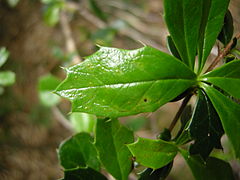Berberis darwinii
| Berberis darwinii | |
|---|---|

| |
| Foliage and flowers | |
| Scientific classification | |
| Kingdom: | Plantae |
| Clade: | Tracheophytes |
| Clade: | Angiosperms |
| Clade: | Eudicots |
| Order: | Ranunculales |
| Family: | Berberidaceae |
| Genus: | Berberis |
| Species: | B. darwinii
|
| Binomial name | |
| Berberis darwinii | |
| Synonyms[1][2] | |
| |
Berberis darwinii, Darwin's barberry,[3] is a species of flowering plant in the family Berberidaceae,[4] native to southern Chile and Argentina and naturalized elsewhere. Regional vernacular names include michay, calafate, and quelung.[5] Growing to 3–4 m (9.8–13.1 ft) tall, it is an evergreen thorny shrub.
Description
[edit]Berberis darwinii has dense branches from ground level. The leaves are small oval, 12–25 mm (0.47–0.98 in) long and 5–12 mm (0.20–0.47 in) broad, with a spiny margin; they are borne in clusters of 2–5 together, subtended by a three-branched spine 2–4 mm long. The flowers are orange, 4–5 mm long, produced in dense racemes 2–7 cm long in spring. The fruit is a small purple-black berry 4–7 mm diameter, ripening in summer.
Berberis darwinii was discovered in South America in 1835 by Charles Darwin during the voyage of the Beagle. It was one of many named in honour of Darwin.[6] The berries of this species are known to have been consumed by prehistoric native peoples[7] in the Patagonian region over millennia.
It is a popular garden and hedging shrub in the British Isles. The Royal Horticultural Society has given the species its Award of Garden Merit.[3] The edible fruit is very acidic.
-
Fruit
-
Leaves
-
Close-up of flowers
Invasive species
[edit]Berberis darwinii is regarded as an invasive plant pest in New Zealand[8] that escaped from gardens into indigenous plant communities via its bird-dispersed seeds.[9] It is considered a serious threat to indigenous ecosystems throughout New Zealand[10] and is listed on the National Pest Plant Accord. In Australia, the species is naturalised in the states of South Australia, Victoria, New South Wales and Tasmania.[11] The species has also become sparingly naturalized in the US states of California and Oregon.[12] It is often planted and sometimes naturalized in Ireland.[13]
See also
[edit]References
[edit]- ^ "Tropicos - Name - Berberis darwinii Hook".
- ^ "Berberis darwinii Hook. — The Plant List".
- ^ a b "Berberis darwinii". Royal Horticultural Society. Retrieved 2020-04-17.
- ^ Chilebosque: Berberis darwinii [1] Retrieved Aug. 2008
- ^ Berberis darwinii at Flora Chilena (in Spanish)
- ^ New York Academy of Sciences, Annals of the New York Academy of Sciences, Published by The Academy, 1909
- ^ C.Michael Hogan (2008) Cueva del Milodon, The Megalithic Portal, ed. A. Burnham [2]
- ^ Darwin's barberry Archived October 14, 2008, at the Wayback Machine, Containment pest plants, Greater Wellington Regional Council website, retrieved 12 January 2009.[dead link]
- ^ Darwin’s barberry Archived 2012-02-14 at the Wayback Machine, DOC's weed work, Department of Conservation website, retrieved 4 January 2011.[dead link]
- ^ Seedling Recruitment of the Invasive Species Berberis Darwinii (Darwin's Barberry): What Contributes to Invasion Success?, McAlpine, Katherine (Kate) Grace, 2005, Victoria University of Wellington doctoral thesis, retrieved 12 January 2009.
- ^ "Berberis darwinii". Australian Plant Name Index (APNI), IBIS database. Centre for Plant Biodiversity Research, Australian Government, Canberra. Retrieved 20 March 2012.
- ^ "Berberis darwinii in Flora of North America". efloras.org.
- ^ Parnell, J. and Curtis, T. 2012.Webb's An Irish Flora. Cork University Press. ISBN 978-185918-4783



